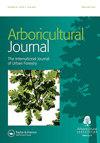Hurricane Tree Damage and Repair
Q3 Agricultural and Biological Sciences
引用次数: 1
Abstract
ABSTRACT During a moderate to severe hurricane more than 5% of trees snap or uproot, depending on the strength and duration of the storm, causing considerable damage to nearby property, housing, and power lines. This study aims to specify the mechanics of trunk damage and possible repair mechanisms. Field data are assembled from trees after hurricane damage to the trunk. Allometric scaling parameters based on trunk diameter (D ^ exp) are determined for the damaged trees’ height, weight, Safety Factor S.F. and critical wind velocity Vcrit. 55% snap via stress fracture of the trunk, 45% by uprooting of the entire tree. Hurricane boundary layer profiles, shear layer forces, Safety Factor (SF), and critical wind velocity Vcrit are determined. Power law exponents (D ^ exp) predict tree height (0.84), weight (2.68), Safety Factor S.F. (0.74), and critical wind velocity Vcrit (0.33) in terms of trunk diameter, with correlation coefficients r = 0.94 to 0.99. Critical velocity Vcrit (wind velocity above which the tree will fail) is found to scale as the Safety Factor S.F.^ (1/2). In conclusion, strategic use of clamps, bolts, tree sap and cables allows restoration of uprooted or snapped trunks for some hurricane damaged trees. Success rate for repair is 67%, average longevity after repair 5.6 years for medium-sized commercially valuable trees.飓风树木损害与修复
在中度到重度飓风期间,根据风暴的强度和持续时间,超过5%的树木会被折断或连根拔起,对附近的财产、住房和电线造成相当大的破坏。本研究旨在明确树干损伤的机理和可能的修复机制。现场数据是从飓风破坏树干后的树木收集的。根据受损树木的高度、重量、安全系数S.F.和临界风速Vcrit,确定了基于树干直径(D ^ exp)的异速缩放参数。55%因树干应力断裂而折断,45%因整棵树被连根拔起。确定了飓风边界层廓线、切变层力、安全系数(SF)和临界风速Vcrit。幂律指数(D ^ exp)根据树干直径预测树高(0.84)、重量(2.68)、安全系数S.F.(0.74)和临界风速Vcrit(0.33),相关系数r = 0.94至0.99。发现临界速度Vcrit(超过该风速树将失败)按安全系数sf ^(1/2)缩放。总而言之,战略性地使用夹子、螺栓、树液和电缆可以恢复一些被飓风破坏的树木的连根拔起或折断的树干。修复成功率为67%,修复后平均寿命为5.6年。
本文章由计算机程序翻译,如有差异,请以英文原文为准。
求助全文
约1分钟内获得全文
求助全文
来源期刊

Arboricultural Journal
Agricultural and Biological Sciences-Agronomy and Crop Science
CiteScore
2.40
自引率
0.00%
发文量
28
期刊介绍:
The Arboricultural Journal is published and issued free to members* of the Arboricultural Association. It contains valuable technical, research and scientific information about all aspects of arboriculture.
 求助内容:
求助内容: 应助结果提醒方式:
应助结果提醒方式:


